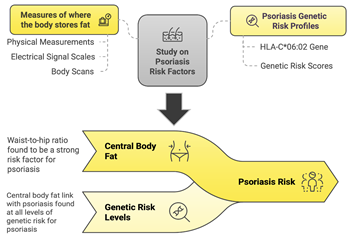19 August 2025
New Lay Summary - Central body fat more strongly linked to psoriasis risk than overall fat
A new lay summary is available for Investigating the Genetic Basis of the Influence of Adiposity on Psoriasis study.
The full paper is available online at: https://doi.org/10.1016/j.jid.2025.03.024 and a full lay summary can be found below.
Central body fat more strongly linked to psoriasis risk than overall fat, large UK study shows
Psoriasis is a long-term inflammatory skin condition that affects millions of people and can significantly impact quality of life. While previous research has shown that higher levels of body fat increase the risk of developing psoriasis, it has remained unclear whether specific patterns or locations of fat matter more than others.
In this study, researchers analysed data from over 330,000 adults in the UK
Biobank, including more than 9,000 people with psoriasis, to understand which
types of body fat are most strongly associated with the condition. They
examined 25 different measures of fat, using both traditional approaches – such
as body mass index (BMI), waist circumference, and waist-to-hip ratio – and
advanced techniques. These included bioelectrical impedance (which uses a small
electrical current to estimate fat content), DEXA scans (a low-dose X-ray that
measures fat and muscle composition), and MRI scans (which use magnets and
radio waves to map fat distribution in detail).
The researchers found that central body fat, especially fat stored around the abdomen, had the strongest association with psoriasis. Measures such as waist-to-hip ratio consistently showed stronger links with psoriasis than general measures like BMI. Four of the five measures most strongly linked to psoriasis were specific to fat stored in the abdominal region. This pattern was particularly strong in women, with several fat distribution measures showing a greater association with psoriasis in females than in males.
Because psoriasis is also influenced by genetic factors, scientists investigated whether genetic risk changes how fat contributes to the condition. One gene in particular, HLA-C*06:02, is a major genetic risk factor for psoriasis. They examined whether the effect of body fat differed in people with and without this gene.
Researchers found that central body fat, as measured by waist-to-hip ratio, had a stronger association with psoriasis in people who did not carry the HLA-C*06:02 gene. However, further genetic analyses suggested that central body fat increased psoriasis risk regardless of a person’s genetic background. In other words, individuals without a strong genetic predisposition to psoriasis experienced a similar influence of central adiposity on their risk as those with high genetic risk. This suggests that body fat and genetic factors contribute independently to psoriasis.
These findings highlight that fat distribution – not just overall body fat – plays an important role in psoriasis risk. Given rising obesity rates, this work supports the use of simple clinical measures such as waist-to-hip ratio to help identify people at increased risk of psoriasis. It also raises important questions about the underlying biological mechanisms linking central fat to psoriasis, which may involve inflammation or immune responses specific to fat stored around the abdomen.
Further research is needed to explore these mechanisms and to determine whether targeting central adiposity through weight loss or other interventions can reduce psoriasis risk or severity.
The full paper is available to read online at: https://doi.org/10.1016/j.jid.2025.03.024
Written by Ravi Ramessur
